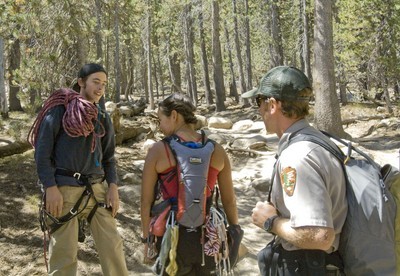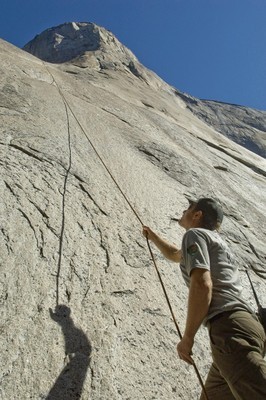Novices take climbing to extremes
YOSEMITE NATIONAL PARK, Calif. -- Evidence of rock climbing's excesses are visible everywhere around the base of a popular summer ascent in Yosemite. Dead pines lie decomposing on the eroded rock, their roots exposed by thousands of boot soles. The approach is marred by 40 separate trails braiding around the granite face.
Then, there's the garbage.
In September, volunteers packed out 900 pounds of abandoned rope, snack wrappers and toilet paper strewn around some of Yosemite National Park's most cherished crags.
Millions of Americans have developed a taste for rock climbing, a fad fueled by a proliferation of urban climbing gyms and glamorized by programs like America's Next Top Model, which recently showed its models hanging from climbing ropes.
As neophyte rock jocks head to national parks to test their skills in the great outdoors, some are breaking the wilderness ethic governing the sport.
Others are violating federal wilderness regulations by drilling into the bare rock face with power tools.
As the sun crested on a recent morning at Yosemite's Tuolumne Meadows, some regulars clipping on chalk bags groused about what they see as an influx of clueless novices, who they assumed were responsible for a heist of $1,000 worth of equipment.
"The next time I see some guy with gear that's mine at the top of the peak, I'm gonna push him off," said Bryan Law, 35, grinning. "Some people just don't know how to behave."
Yosemite's mammoth granite formations have a singular allure for climbers eager to push the limits.
Cathedral Peak, a 10,900-foot temple of rock rising from Tuolumne Meadows, is often where newcomers start.
Rookie Ha Pham, 23, hopes to venture up it eventually, but said she was concerned the conditions she'd find wouldn't meet her standards.
"They should have signs and stuff and trash cans outside," said Pham, who climbs regularly in the safety of a San Francisco gym. "I don't think they even clean your rocks off for you out there."
Yosemite's full-time climbing ranger Jesse McGahey is on a quest to teach such newbies how to develop technical skills and outdoor ethics at the same time. McGahey prefers to educate newcomers about the wilds rather than ticket them.
But on a recent weekend, when he came across an abandoned dog tied to a tree in the middle of bear country, he felt had no choice but to fine its owner $225 as he came strolling down from the summit.
"In the Seventies, people used to teach each other how to climb outdoors," said McGahey, 29. "Now a lot of people come out of the gym and head straight for the woods, with no idea of what they'll find there."
Other popular climbing destinations also are struggling to keep a balance between preserving the backcountry and helping gym rats aspire to something higher.
An Outdoor Industry Association survey showed the number of climbers grew from 7.5 million to 9.2 million from 2004 to 2005. The percentage of people climbing on an artificial wall rose 30 percent.
Many newcomers don't learn the traditional climbing style developed in the 1960s, but instead learn in a gym, where man-made walls feature bolts every three feet.
Young climbers often start out bouldering, a ropes-free style that helps build strength, but can also leave forest floors strewn with chalk and abandoned crash pads.
"There are lots of people out cruising around the woods looking for really fun boulders to climb on," said Phil Powers, executive director of the Golden, Colo.-based American Alpine Club. "But one of the biggest concerns that we have is that gym-to-outside transition."
In Southern California's Joshua Tree National Park, boulders are riddled with holes and stakes marking climbing routes. Rangers say the problem alters the landscape for nonclimbers visiting the park and accelerates erosion of the rock formations.
At Arches National Park in Utah, officials feared climbers would damage delicate sandstone formations, so last year they banned slacklining, a strength- and balance-building exercise that requires walking on a nylon rope strung between natural features.
They also banned climbing on any arch named on a topographical map of the park, a United States Geological Survey guide climbers follow.
At Red Rock Canyon National Conservation Area, near Las Vegas, managers are considering placing a 10-year cap on the number of bolts and anchors climbers can wedge into the sandstone. They hope to encourage climbers to use natural protection instead of the quick approach favored by novices: drilling more gear into the wall.
"People are looking for weekend escapes," said Rick Potts, the former Conservation and Outdoor Recreation Chief for the National Park Service. "Trips are getting shorter, and trips into the backcountry are getting less and less common."
McGahey approaches Yosemite's visitors his own way.
To prevent erosion near Cathedral Peak, he's working with volunteers to block the braiding trails with dead logs. He and the nonprofit Yosemite Climbing Association recruited climbers to remove 21 tons of garbage throughout the park in last month's annual trash pickup.
Rock climbers don't need a backcountry permit even if they spend the night slung off the side of El Capitan, the park's famed granite monolith, so McGahey stresses leave-no-trace camping techniques.
Kay Okamoto, a Los Angeles-based urban planner who climbs at a gym during the week, takes all the tips she can.
"More people keep coming up here and getting stoked about going cragging," said Okamoto, 26. "What you learn about the environment is really all in who you meet."


















